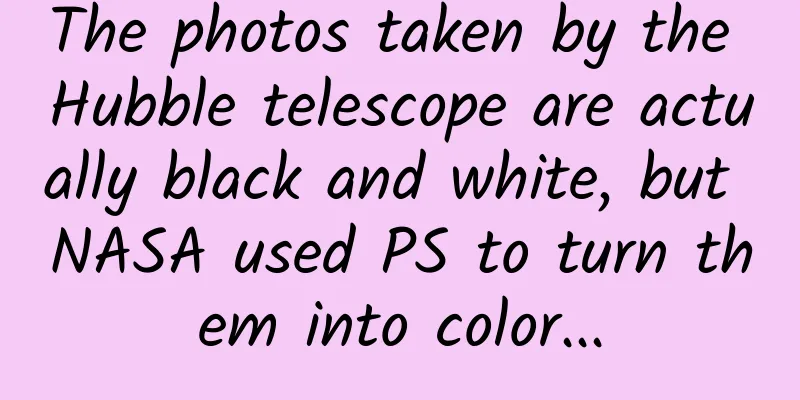The photos taken by the Hubble telescope are actually black and white, but NASA used PS to turn them into color...

|
In the Cat's Eye Nebula three thousand light-years away, a dying star emitted the last light of its life. After three thousand years, this scene happened to be "seen" by the Hubble telescope and presented to everyone. The Hubble Telescope has been in service for more than 20 years since its launch in 1990. During this period, the Hubble Telescope has taken many iconic photos of the universe, such as the famous Pillars of Creation and the Cat's Eye Nebula mentioned at the beginning, allowing us to see the beauty of the universe that is far beyond the reach of human eyes. But in fact, the Hubble telescope has never seen these colorful cosmic scenes. The images of the universe it captures are not in color, but in shades of black and white. This is because the Hubble telescope's camera uses a special electronic detector, a CCD detector (charge-coupled device), which can sense the spectral range of cosmic light but cannot display the color of the incident light. In addition, the main principle of the Hubble telescope's photography is based on the brightness of reflected light. For cosmic objects thousands of light years away, black and white images are the most intuitive and clear. NASA colorizes black and white photos The raw data captured by Hubble is transmitted back to NASA's ground-based observatories and then handed over to astronomers for research. However, if the observatory directly releases these raw photo data, most people will not be able to see the celestial structure and information contained therein. Out of consideration for the public, NASA decided to "beautify" the photos and add some color. Therefore, the universe photos from Hubble that we see now are actually color photos synthesized by NASA using PS. But by doing this, isn't NASA deceiving the public? The photos sent back by Hubble are obviously black and white, but you "unauthorized" to colorize the photos. And how can NASA ensure that the colors of each area are accurate? Let’s go back to the Hubble telescope. Although the pictures it takes are in black and white, they all contain color information. In fact, light from astronomical objects has many colors, each color corresponds to a specific type of electromagnetic wave, and as we mentioned earlier, the Hubble telescope's CCD detector can sense the spectral range of light. Hubble can therefore detect all wavelengths of visible light, as well as many more that are invisible to the human eye, such as infrared and ultraviolet. Astronomical objects appear different in light of different wavelengths. In order to record astronomical objects at different wavelengths, Hubble uses special filters. Filters can be broadband or narrowband. Broadband filters allow multiple colors to pass through, such as the entire red region or the entire green region of the spectrum; narrowband filters only allow a certain band of light to pass through, usually at the atomic level. With the filter, the Hubble telescope can take pictures of the same astronomical object at different wavelengths. After the original photo data recording specific wavelengths are transmitted back to NASA, it is time for their "PS" team to perform. Before that, I would like to give you a brief introduction to the three primary colors of RGB. RGB represents the colors of the three channels of red, green and blue. This standard covers almost all colors that can be perceived by human vision. It is one of the most widely used color systems at present and is also the basis for NASA coloring. Let's start with a simple one. Taking the photo of Saturn as an example, researchers will use the "broadband filtering" method to divide the broadband filter photos sent back by Hubble into three different wavelength bands: long, medium, and short. The three black and white images are then assigned colors based on the corresponding positions of the wavelength bands, with long waves being assigned red, medium waves being green, and short waves being blue. After combining these three photos through PS, we get a "true color" photo, but this method is only suitable for astronomical objects with few colors and simple surrounding environment. However, there are many nebulae and galaxies in our universe, and the colors and environment of these astronomical objects are more complex. At this time, researchers can only "colorize" the pictures by tracking the colors of different gases in the universe. This method is called "narrowband filtering." For example, the famous photo of the Pillars of Creation. The Pillars of Creation are composed of huge nebulae and cosmic dust. These nebulae are full of hydrogen, oxygen and sulfur. Hubble recorded the narrow bands of light of these elements through narrow-band filters. Since the energy wavelengths released by the electron transitions of the elements are different, different elements will also have different colors. According to the element spectrum, red represents sulfur, green represents hydrogen, and blue represents oxygen. Finally, I used a palette to composite the image, ensuring the correct composition of the nebula while having the highest color contrast, and then composited it into a color photo. Oh, by the way, for visual considerations, sometimes the photos will be enhanced, such as adding a little light and shadow to the nebula, adding brighter light to the stars, etc. After these steps are completed, a "colored" picture containing accurate astronomical information is produced. After NASA publishes it on the Internet, even the general public can understand these astronomical photos. During the more than 20 years that Hubble has been in service, NASA's "PS" team has produced tens of thousands of stunning images. This team has extensive knowledge of astronomy, and the images they produce are both scientific and communicative. Moreover, these pictures produced by NASA are free to the public. It doesn't matter if you don't indicate that they are from NASA when you use them, because they took the original pictures and photoshopped the pictures that are circulated. Who can ask them for copyright fees? Their main purpose is to spread the pictures more widely. Colorizing photos is not just for the public, astronomers also want the images to look better, because higher contrast somewhere in the universe or some bright spots elsewhere can help them understand the complex structures and relationships between nebulae. So don't blame NASA for some photo manipulation. They are working hard for science. |
<<: "Lunar Shield", Earth-Moon Live Broadcast... The Secrets of "Alone on the Moon"
>>: How many turns are needed to restore the Rubik's Cube?
Recommend
Tik Tok weight and account maintenance strategy
In fact, there is no such thing as "account ...
This year was supposed to be a warm winter, so why is our country "the only coldest in the world"?
Recently, North China broke the historical low te...
Several ways to quickly create popular articles in self-media and public accounts
Several ways to quickly create popular articles i...
6 basic elements of complete event promotion planning
Before sharing your content, please consider the ...
Promoting activation and retention: analysis of user growth system design
1. What is the user growth system? The evolution ...
Scientific rumor-busting | The chemistry in fireworks and firecrackers
General Secretary Xi Jinping pointed out: "S...
This "sunscreen magic tool" is really risky if used incorrectly! Many people still use it on their children...
Summer is coming Various "sunscreen magic to...
How much does it cost to develop a Dali bargaining app? Dali bargaining applet production price inquiry
How much is the production price of Dali Bargaini...
What types of WeChat Mini Programs are there? What are the categories of WeChat Mini Programs?
Q: What types of WeChat Mini Programs are there? ...
Which "anti-human" designs in life are actually very scientific?
appendix: References: Source: A scholar The cover...
Guangzhou recipe mini program function, how much does it cost to develop a home cooking mini program?
As those born in the 1990s and 2000s have started ...
International Civil Aviation Day丨The sky was clear, why was my flight delayed again?
With the arrival of cold waves, rain and snow, la...
Do product managers need to learn technology? Here is the best answer
I have always believed that learning new knowledg...
Java Thread Interview Questions
[[147712]] Below are some Java thread-related int...
Why do you always pay the balance at night? Are you afraid I'm not impulsive enough?
Review expert: Taozi National Psychological Couns...



![[Popular Science China Star Chasing Dreams] He spent his life in natural sciences, and he was a master of geology who traveled all over the mountains and rivers](/upload/images/67f23f8295473.webp)





